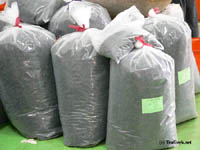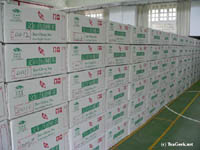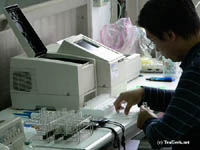One of the experiences I had in Taiwan was to visit Pinglin, where a famous tea competition is held at least twice each year–for the Spring and Winter tea seasons. Pinglin is a township in Taipei County, a little more east than south of the city of Taipei in northern Taiwan. On the one hand, it was disappointing because we got there when the weather was awful for tea picking and processing. On the other, we got there on the first day that farmers were bringing in their entries for the Winter competition.
 It was an interesting process to see, with lots of people working very fast. First, the farmer would arrive at the school gymnasium with a large sack of tea weighing about 28 pounds (or just over 12.6 kilos). The sack would be weighed, and a number would be assigned. Forty-two metalic bags and a small plastic zip-close bag would be put into the farmer’s sack. All 43 inserted bags would have already been labeled in advance with the assigned number by the industrious people at the first table. A person further down the table would take some of the tea and put it in the zip-close bag and set it aside.
It was an interesting process to see, with lots of people working very fast. First, the farmer would arrive at the school gymnasium with a large sack of tea weighing about 28 pounds (or just over 12.6 kilos). The sack would be weighed, and a number would be assigned. Forty-two metalic bags and a small plastic zip-close bag would be put into the farmer’s sack. All 43 inserted bags would have already been labeled in advance with the assigned number by the industrious people at the first table. A person further down the table would take some of the tea and put it in the zip-close bag and set it aside.
 Next, the big sack was taken to one of five tables scattered around one side of the gym. Each table was covered in plastic and was attended by six or seven people, mostly women with generally a man supervising or auditing. The 42 metallic bags are taken out and the tea is dumped on the plastic-covered table. Each of the metallic bags holds half a jin of tea. (A jin in Taiwan is 600 grams, which is slightly more than either 21 ounces, or 1.3 pounds. To be confusing, in mainland China, a jin is 500 grams, or about 1.1 pounds.) Most of the people at the table scoop up roughly a half-jin of tea and put it in one of the bags. They are then given to a person with a scale who fine-tunes the weight to exactly 300 grams per bag. The bags then go to yet another person who heat-seals each bag and packs them into two boxes labeled with the appropriate lot number. Ten jin (20 bags) fit in each box, for a total of 20 jin. The other two bags don’t fit into the boxes.
Next, the big sack was taken to one of five tables scattered around one side of the gym. Each table was covered in plastic and was attended by six or seven people, mostly women with generally a man supervising or auditing. The 42 metallic bags are taken out and the tea is dumped on the plastic-covered table. Each of the metallic bags holds half a jin of tea. (A jin in Taiwan is 600 grams, which is slightly more than either 21 ounces, or 1.3 pounds. To be confusing, in mainland China, a jin is 500 grams, or about 1.1 pounds.) Most of the people at the table scoop up roughly a half-jin of tea and put it in one of the bags. They are then given to a person with a scale who fine-tunes the weight to exactly 300 grams per bag. The bags then go to yet another person who heat-seals each bag and packs them into two boxes labeled with the appropriate lot number. Ten jin (20 bags) fit in each box, for a total of 20 jin. The other two bags don’t fit into the boxes.
 Ah, but there’s a method to this madness. The two boxes are then stacked in the half of the gym where nobody is working. (Over the course of the 5 days when entries can be delivered, that half of the gym will be more or less filled with tea. Next time you’re in a gym, think of half of it filled with tea leaves and consider how much space the ounce or two you typically buy at your local tea shop takes up. It’s a staggering amount of tea.)  The two forlorn bags that didn’t fit into the neatly stacked boxes are eventually taken to the building where the judging happens. This last “extra” jin is what gets brewed for the judges. Any tea left from the original farmer’s sack is put back in and given back to him. Even though it’s from the same batch, it cannot legally be called competition tea because it’s not in the special numbered bags.
Ah, but there’s a method to this madness. The two boxes are then stacked in the half of the gym where nobody is working. (Over the course of the 5 days when entries can be delivered, that half of the gym will be more or less filled with tea. Next time you’re in a gym, think of half of it filled with tea leaves and consider how much space the ounce or two you typically buy at your local tea shop takes up. It’s a staggering amount of tea.)  The two forlorn bags that didn’t fit into the neatly stacked boxes are eventually taken to the building where the judging happens. This last “extra” jin is what gets brewed for the judges. Any tea left from the original farmer’s sack is put back in and given back to him. Even though it’s from the same batch, it cannot legally be called competition tea because it’s not in the special numbered bags.
 Meanwhile, that little zip-close baggie of tea that was separated at the beginning of this process is taken to the ground floor of the building where, upstairs, the judging will occur. Below, however, are a couple of people hard at work brewing samples of tea. They, however, don’t get to drink it. Instead, they put the tea in fancy scientific equipment to test the samples for pesticides and agricultural chemicals (which was something that took a while for me to figure out–I didn’t know the Chinese term for “pesticides and agricultural chemicals” and the closest our friend Mr. Tsai knew in English was “medicine.” Thank goodness for Pleco!)
Meanwhile, that little zip-close baggie of tea that was separated at the beginning of this process is taken to the ground floor of the building where, upstairs, the judging will occur. Below, however, are a couple of people hard at work brewing samples of tea. They, however, don’t get to drink it. Instead, they put the tea in fancy scientific equipment to test the samples for pesticides and agricultural chemicals (which was something that took a while for me to figure out–I didn’t know the Chinese term for “pesticides and agricultural chemicals” and the closest our friend Mr. Tsai knew in English was “medicine.” Thank goodness for Pleco!)
Since we were there on the 12th of November and the actual judging didn’t start until, I think, the 20th. If my understanding of the explanation wasn’t too far off and my memory holds, the three days of judging were November 20th through the 22nd, and the winners were announced on the 24th. But Mr. Tsai and Mr. Chen did treat us to a tasting of three submissions (but I don’t know their numbers so I can’t tell if any of them won or not).
My friend and tea teacher, Shiuwen Tai, now has available the First Place, Second Place, an Honorable Mention, and one of her supplying farmer’s personal favorites (“Farmer’s Choice” she calls it). I have some tea made by the Second Place farmer, but it wasn’t the same batch that won. Check out mine at the Tea Geek Store, and Shiuwen’s at FloatingLeaves.com. Get a little of each and taste them side-by-side!







